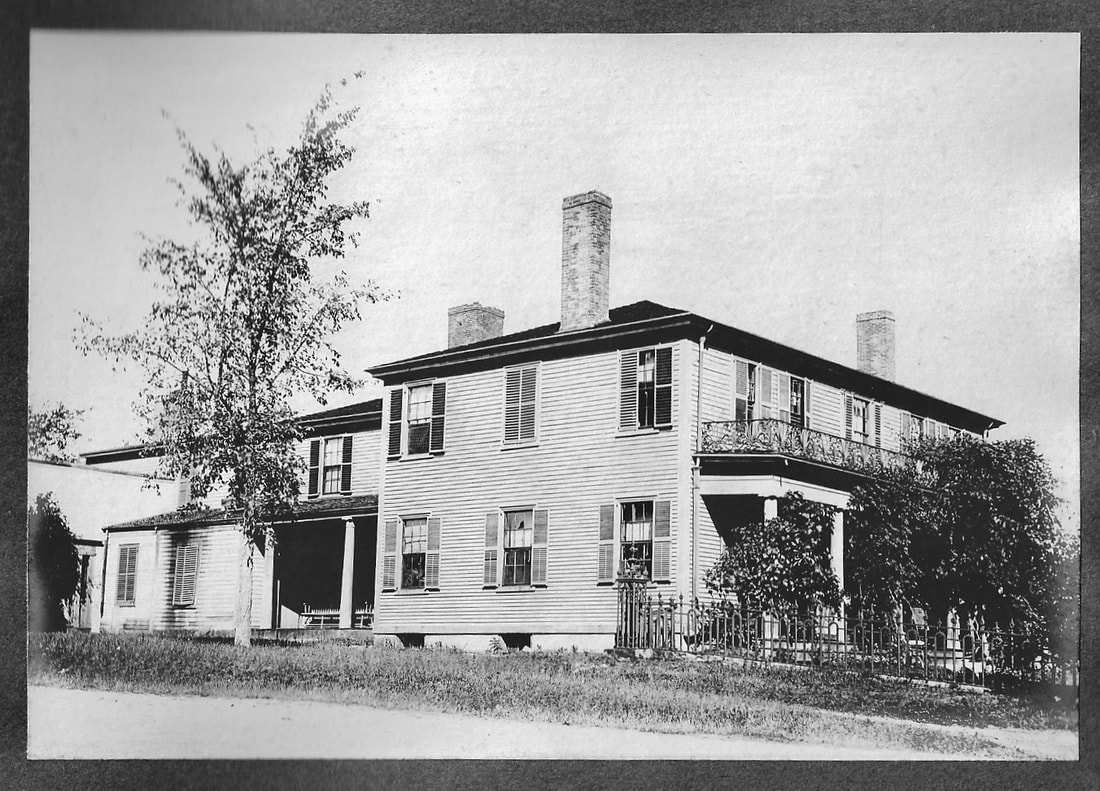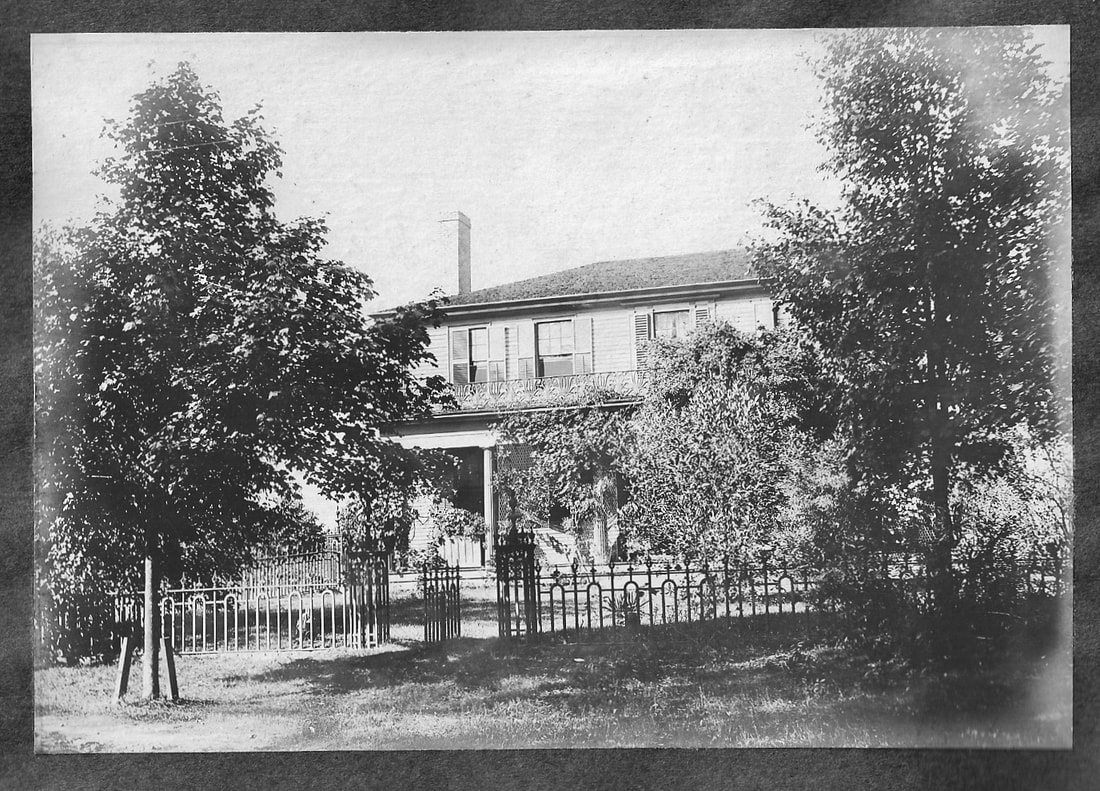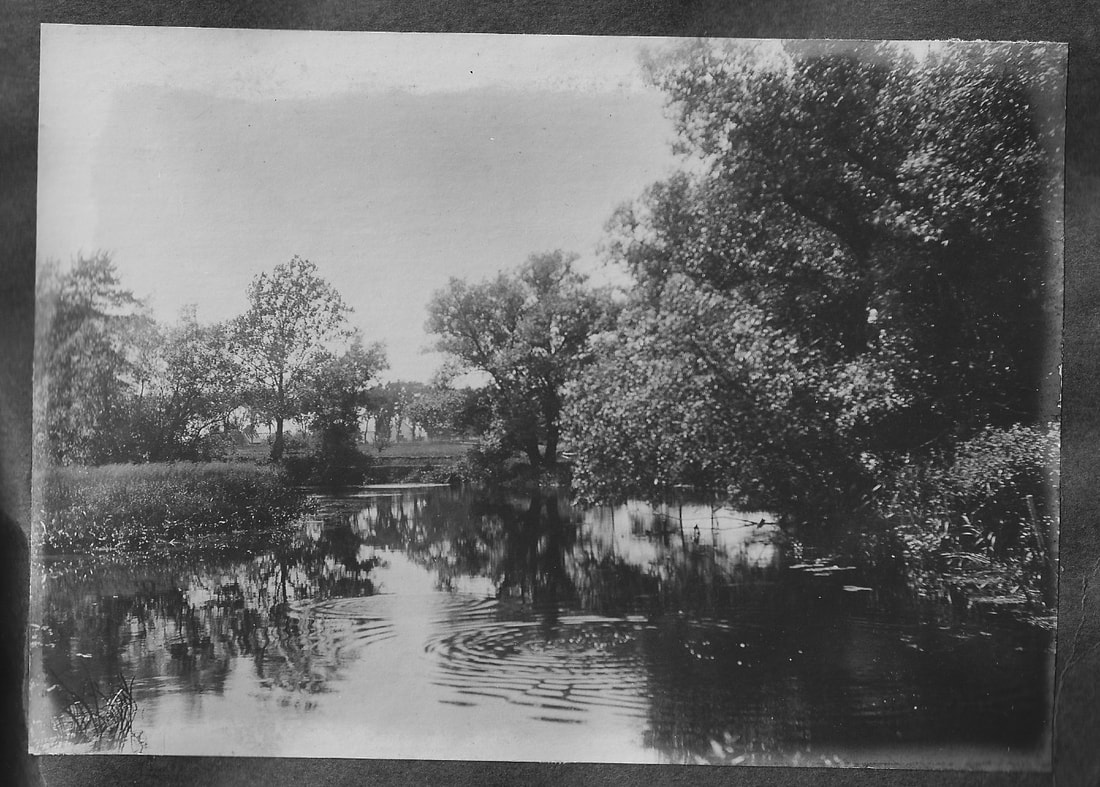|
Hello fellow history lovers! The end of September brought with it a bit of late summer, with warm, sunny days and cool evenings! I spent time this week preparing my kindling for the winter heating season, which will get here soon enough. Pretty soon these warm days will be replaced by a warm seat near a hot wood stove.
Today's photos from the Belcher album, which we are nearly through, are nice reminders of a much simpler time, but also reminders of one thing that frustrates historians - unidentified photos! Sometimes we might be able to identify a location from hints in a photo, and on a rare occasion, someone might recognize an ancestor and from there we might be able to identify other people in a photo. Perhaps someone out there might surprise me with a name or two, so here goes! The first photo is one full of style and surprises too. Two older men, looking a bit long in the tooth, stand to the right of a much younger group of people. All of them appear to be dressed in their "Sunday best" for this photo. The girls have on their prettiest dresses and except for one who looks like she can't wait for this to get over with, offer slight smiles. The young boy in the high stockings, knickers and ruffled top seems to be at least tolerating the photo session. But my two favorites are the men on the right, the grizzled old gentleman in the stovetop hat and pants that may never, ever come clean, and the man on the far right who sports a very Captain Ahab looking wooden leg! One would wonder if he was a Civil War veteran who suffered a devastating injury. One name that does come to mind, suggested many years ago by Kippy Grant, is that he might be Ellie Gibbs, who had such a wooden leg, but that has yet to be verified, if indeed it can. The second portrait is very different. It depicts a local woman, perhaps a family member, in front of a grapevine with a basket of freshly picked grapes. In contrast to the previous photo, she appears to be genuinely pleased to have her picture taken, and her relaxed smile adds to the sweet mystery of who she is. A close look at her face reveals a ruddy complexion, perhaps from years of working outdoors in all kinds of weather as she planted, and later, harvested crops. Her clothing is well-suited to her needs with layered dresses and petticoats and a shawl to keep her warm, and a brimmed bonnet to protect her from sun exposure. And then there are the grapes - for jelly, or for wine? Clearly, her work is not done, although I am grateful that she lives on, albeit anonymously, caught in a moment of time for us to reflect on. Wishing you health as we continue to work our way through these more complicated times, Frank
0 Comments
Hello! A fall chill in the air brings thoughts of warm apple cider donuts and aromas of hot cocoa to mind today. Leaves are beginning to turn color, and in a few weeks time, nature will be full of her glory. However, there are times when the natural world can be full of wrath as well, and the current very busy hurricane season bears witness to that.
Today we turn to a few photos that helped to date this Belcher photo album. On November 26 + 27, 1898, New England was hit by a storm of epic proportions, formed by the merging of two weather systems. It is known as the "Portland Gale" and as far as I know, is the only New England storm named for its victims. The storm battered southern New England on the weekend after Thanksgiving, when many travelers would be returning to their homes after visiting relatives. The timing could not have been worse. The 280 foot long side wheeled steamer Portland left Boston on the afternoon of the 26th to bring passengers to Maine, a trip she had made many times over the years. However, by mid-morning on the 27th, it was apparent that the ship and her nearly 200 passengers did not survive. Wreckage began washing up near Race Point in Provincetown and other areas around the tip of Cape Cod. The loss of life from that one wreck stunned the area, and the storm became known for its most famous victim. A total of 400 lives and 150 vessels were lost during the storm. On the South Shore, tidal surges actually changed the course of the North River. People rowed dories down Atlantic Avenue in Boston. And in the coastal towns, wind, flooding, and erosion from high surf took their toll. The photos here are of cottages that were damaged or destroyed at Brant Rock, Massachustts, a result of the Portland Gale. For many years, Brant Rock was a summer vacation spot for many people, and a number of Eastoners owned or rented cottages during the summer. Local organizations, such as the Outlook Club in Easton, had summer gatherings and outings at cottages owned by members. The Belcher, Drake, and Heath families were among those Eastoners who owned property at Brant Rock, and presumably, the cottages pictured here are those that were once owned by these families. Let us hope that the current hurricane season, which has already caused devastation for our southern neighbors, does not repeat history. Until next week, stay well! Frank Hello everyone,
The fall newsletters will be in the mail this week for our members. You will immediately notice an empty calendar section, an unfortunate casualty of the times we are living in. We hope to have it full again with the next issue as we look forward to the holiday season. Just in time for election season, Robert N. Brooks has shared a great story of a very special visitor to North Easton! Watch later this week for some new announcements on the latest issue of Reminiscences, and a new website! Stay well, Frank Hello all! What a beautiful fall morning it is here in Easton. There is a distinct chill in the air, the sun is shining, and there is even a hint of the fall colors in some of the trees around town.
Today's photos from the Belcher photo album are of the Shepard Leach House, 555 Foundry Street. It was built around 1810 for Shepard Leach and his wife Phebe (Torrey) Leach. Shepard's father Abisha was already known in Easton, having arrived here before 1800, when he bought an interest in the former Perry Foundry at the site of Old Pond on Foundry Street. Shepard's wife Phebe was originally from Pembroke, and the Leach family was from Bridgewater. Shepard Leach eventually obtained full ownership of the old foundry, and had a number of other foundries and furnaces in surrounding towns. By all accounts he was the wealthiest man in Easton for most of his life (1777 - 1832) until he was surpassed by Oliver Ames in later years. The Leach House, built around 1810, was one of the most prominent homes in Easton for many years. A classic Federal style, it was rather large for a two person household, as the Leaches did not have any children. However, census records invariably record as many as 20-40 other people residing there at different points in time. Some were probably domestic servants; some may have been workers who worked at the foundry at a time when there was little worker housing available (the Drakes, who later owned the home, also seemed to have provided some type of living arrangements for workers in those early years); others were orphan girls, who were taken in by the Leaches and given training in domestic work so that they could eventually support themselves as they grew old enough. Shepard and Phebe had the means to do such things, and they were foster parents to an unknown number of young girls who might otherwise have had very different lives. The first photo shows the house from Poquanticut Avenue and Foundry Street, where the size of the house is fully on display. Note the full front porch and the iron railing across it. The other photo is taken looking west along Foundry Street. Note the ornamental iron fence that still stands on the property. All of the iron work was made at the old foundry. There are two stories connected with this house to share today. The first is that upon completion, Daniel Wheaton, also a man of some means, had a rivalry with Leach. Wheaton built a new home at 519 Bay Road just after Leach moved into his home. The Wheaton home is nearly an exact replica, except for two things: it was built slightly larger than the Leach home, and it had more elegant trim! I hope it was a friendly game of one-upmanship. The second story is more recent. The Bulfinches, Arthur and Caroline (she was a descendant of the Drakes), lived in the Leach house from the 1930's until 1980. Arthur worked in the Belcher Foundry office, which was across the street from his house. The Belcher foundry was sold during the early 1970's to a larger corporation, Dayton Malleable. Arthur had retired by this time, and the foundry still operated directly across Foundry Street. The new owners had begun an overnight shift, and sometimes during the early morning hours, very heavy iron ingots,or pigs, would occasionally be dropped, which resulted in a sudden and voluminous noise that startled Arthur and his wife from their sleep. Several calls to the foundry over the course of a few weeks did not resolve the issue. When the sudden noises continued unabated, Arthur began calling the chairman of Dayton Malleable at home each night he was awakened, regardless of the hour. Within a few days, all of the noise stopped. Watch for an exciting email early next week about a new book and a new and improved website! I hope you enjoy the photos of this wonderful home, and until next week, stay well! Frank Greetings on this beautiful Labor Day weekend! The sun is shining beautifully here this morning, and a slight breeze moves across the surface of Shovel Shop Pond, creating pinpoint "diamonds of light" as the water gently ripples from the movement of the air just above it.
Water can give us some of our most extraordinary photos, and capturing the motion of water is something that has attracted photographers since the invention of photography. Our two photos today from the Belcher album demonstrate experiments with water in motion, and hint at the talent of the man behind the lens. Keep in mind the late 19th century equipment and photographic plates that were in use at the time, and you will appreciate our Mr. Belcher's ability to capture both the beauty and the power of water. The first image is rather pastoral in nature. A peaceful and still body of water is interrupted by two sets of ripples, undoubtedly radiating out from the impact of two small stones that were tossed from the photographer's hand. At just the right moment, those ripples are captured in time for us to view almost 125 years later. I think that this location may be a small pool of water behind the Heath Farm, probably Gallows Brook which is a tributary of Black Brook. The second image is just the opposite of the first. Here, the photographer uses his skill to capture a wave crashing into a ledge. He times the exposure to the very moment that the water, flowing quickly and powerfully, violently rises as it meets the immovable rock, leaving us with an indelible image. I sure wish I knew how this photo was timed, photographed, and how long it took (or how many tries!) to get this particular shot in the days before high speed film and high speed cameras were commonplace. I believe this image may have been taken in the Brant Rock area of Massachusetts. I have a few more photos to share in the next two weeks from this album before moving onto other things. Please stay healthy, and until next week, Frank |
Author
Anne Wooster Drury Archives
June 2024
Categories |
Easton Historical Society and Museum
PO Box 3
80 Mechanic Street
North Easton, MA 02356
Tel: 508-238-7774
[email protected]









